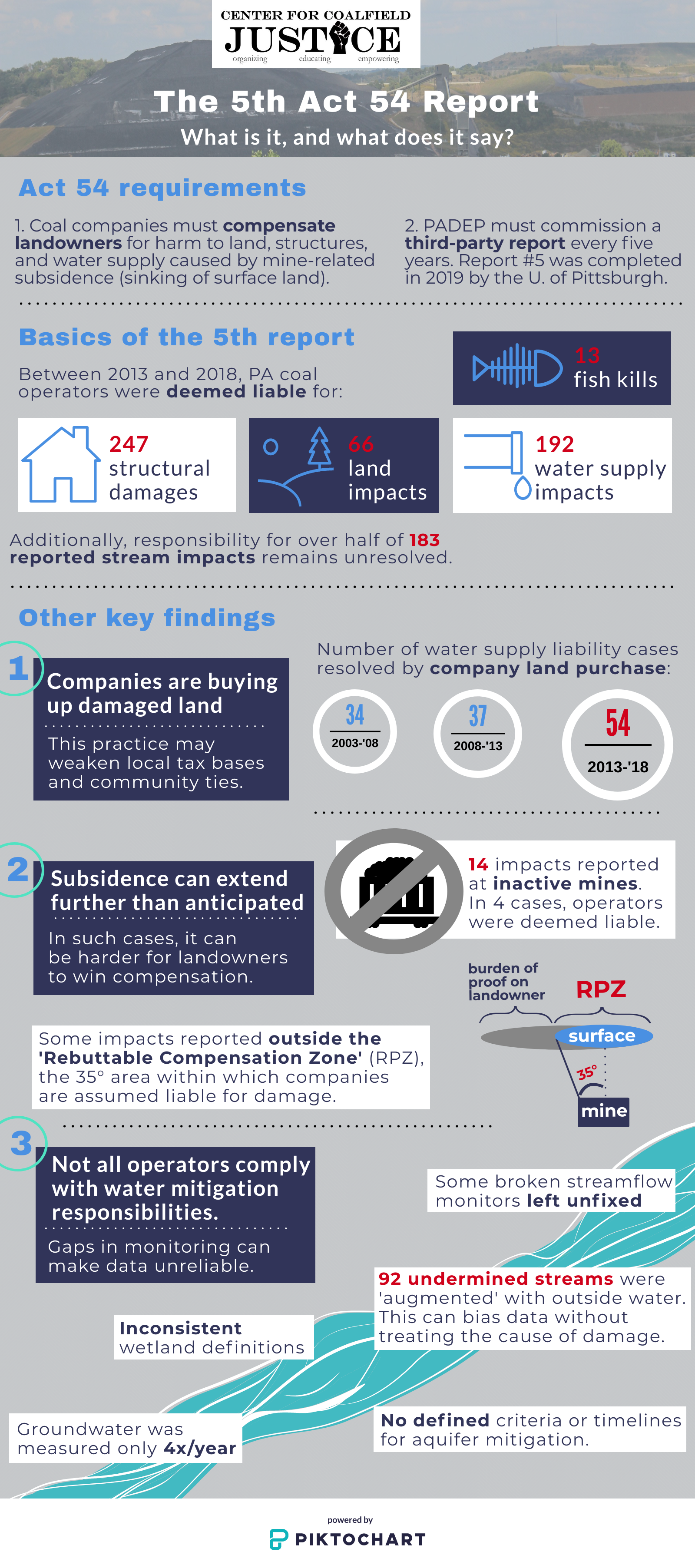
The 5th Assessment of Act 54 (the law regulating underground coal mining) was recently completed by nineteen (19) researchers from the University of Pittsburgh and the Carnegie Museum of Natural History. This study, which addresses the effects of mine subsidence due to underground coal mining activity, focused on active mines and damage report claims from August 21, 2013 to August 20, 2018. Act 54 became effective in 1994 and is a piece of Pennsylvania legislation that extended the obligation of coal companies to pay for damages caused to homes, businesses, water sources, and other structures (barns, sheds, outhouses, etc.). The University of Pittsburgh has been tasked to do the last three (3) assessments (2003-2008, 2008-2013, and the most recent, 2013-2018). These assessments have led to some modifications of Pennsylvania Department of Environmental Protection’s [PADEP’s] reporting requirements associated with mining permits, and have also helped to enhance the effectiveness of the Act.
The current report found that there were 192 cases where water supplies were impacted and that the company was liable, compared to 371 in the previous assessment (2008-2013). Although this number has decreased, the amount of surface land that coal companies buy before, during, and after mining has increased. For instance, in the current Harvey Mine Expansion, Consol owns nearly half of the property above the mining area. Coal companies generally do not report damages that occur on these swaths of land. Additionally, within the last few years, companies have begun to offer landowners a one-time lump sum before mining begins in exchange for directing issues to the company instead of the PADEP. This practice filters and skews the data available for Act 54 assessments. Thus, an apparent downward trend in overall coal mining impacts evidenced by the most recent report may be misleading. Not only do these practices bias data in favor of coal operators, but companies also decimate the tax base by systematically removing people from undermined areas.
Like previous assessments, the 5th demonstrates the negative impacts that coal mining has on communities. This report also raises new concerns: Landowners may experience subsidence damage long after a mine has become inactive, or on property outside of the area within which certain mine operators are assumed to be liable for damage. These developments are concerning because they mean landowners may find it harder to get compensation. In general, as time passes it becomes increasingly difficult for undermined landowners to successfully demonstrate that the company is liable for subsidence damages. Although most mine subsidence occurs shortly after the mine passes under a piece of property, this assessment tracked a marked increase in surface damages years after mining activity had ended. Additionally, damages outside of the Rebuttable Compensation Zone (AKA the area within which a company is assumed to be liable for subsidence damage) have increased in the current assessment period. Undermined residents without the resources to hire a good attorney may find it nearly impossible to resolve these issues.
Some legislators want to change the Act 54 assessment process due to the increasing costs of producing the report. Yes, the cost of doing the study has gone up, but let’s look at some of the reasons why. The current assessment emphasizes that both previous assessments have VIGOROUSLY recommended that the PADEP update their data collection software. For ten (10) years, the PADEP has been told that their system is out of date. For instance, the researchers explain that, toward the end of the 4th assessment, they began to receive data in electronic spreadsheets rather than in hard copy form as before. However, mid-way through the 5th assessment they started receiving hard copy forms of data again. This regression made their work unnecessarily prolonged and tedious. The researchers also described another instance in which data miscommunication increased the amount of time spent drawing up the report: “The University could not easily be provided access to the data viewing and entry screens the PADEP uses to enter and use BUMIS [PADEP’s outdated data collection software]. This led to confusion and misinterpretation on the University side. For example, the narrative documented in BUMIS by field agents was not included in initial data transfers to the University. These data were not provided to the University until September 2018, well into the project period. This led to substantial effort to understand strange cases, many trivial questions from the University to the PADEP in early periods, and temporary confusion by both parties” (Section 12: Recommendations from the 5th assessment). The study period was from 2013 to 2018, but a large portion of data was unclear to the researchers until September 2018!
In the conclusion of the report, researchers state, “Continual movement toward an integrated analytical approach to subsidence effects would improve protections for the Commonwealth.” This statement points toward the unknowns that continue after five assessments on the impacts of underground coal mining. Researchers also state “to take the next step and embrace the ability to do more with less, achieving the needed investment will require advocates from the bottom to the top of the organization and the Commonwealth.” Improving testing and data management will cost the Department money, but in the long run this investment will vastly improve homeowners’ abilities to protect their households and the things they work and live for.

